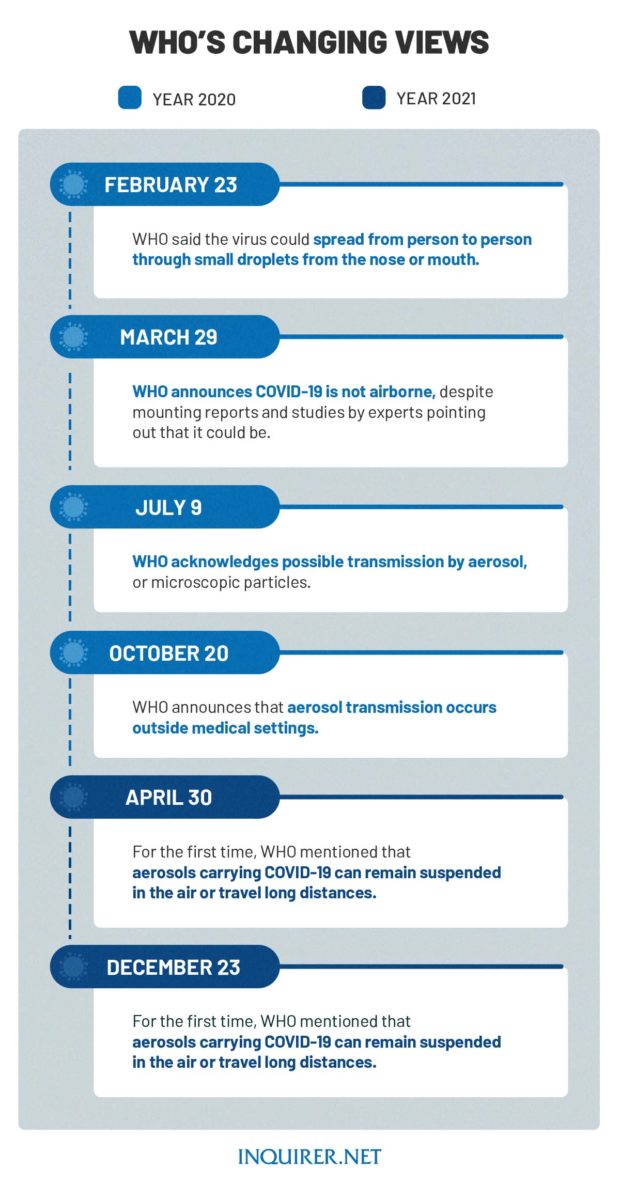COVID is airborne and why it took WHO 2 years to admit it
MANILA, Philippines—Earlier this year, President Rodrigo Duterte expressed bewilderment about how Omicron, a variant of the COVID-causing virus SARS Cov-2, was able to infect more people, including those who just stayed home.
“This Omicron has hit so many people who wear masks, who are vaccinated. Even those who just stay at home, they get infected,” Duterte said, speaking in a mix of English and Filipino, addressing his question to Health Secretary Francisco Duque in a taped meeting aired last Jan. 17.
“There are others—or there are many of them—who are vaccinated who still get infected. Is that airborne? There are so many people who are already wearing masks who still get infected,” Duterte went on.
READ: Duterte asks: ‘Is COVID-19 airborne?’ Duque blames spread on ‘token compliance’ with rules
Duterte raised two questions in total—first was how even people at home who followed health protocols still got infected with the COVID variant. Second, he asked Duque whether the COVID. virus is airborne.
In this article, INQUIRER.net will try to provide answers to both questions, and discuss one of the overlooked observations in terms of answering whether the COVID virus is airborne, which took World Health Organization (WHO) two whole years to acknowledge.
Indoor transmission
Duque, who was asked to answer Duterte’s curious question, did not categorically answer whether the COVID virus is airborne.
However, he pointed to “token compliance” of minimum health standards, like improper wearing of face masks, as a possible reason for the spread of Omicron.
“Those who get infected are either wearing their mask wrongly or with their nose sticking out. That’s useless. That is what we call token compliance, but it’s the wrong way of doing things,” Duque said.
“It is the wrong way of complying with our minimum public health standards. For example, when it comes to avoiding contact, instead of [distancing] one meter, people talk close together,” he added.
The health secretary also cited the recent holiday celebrations which might have caused at the time a surge in COVID cases.
READ: Blank space left in 2022 PH budget: Funds for free COVID tests
To further explain how COVID spreads among people—even within households that follow health protocols—WHO stated that the SARS-CoV-2 virus spreads “mainly between people who are in close contact with each other, for example at a conversational distance.”
“The virus can also spread in poorly ventilated and/or crowded indoor settings, where people tend to spend longer periods of time,” WHO said on Dec. 23, 2021.
Yes, it is ‘airborne’, but…
On its website, WHO also said last year that the COVID virus can be transmitted among people in poorly ventilated, crowded indoor settings because it is airborne.
“This is because aerosols can remain suspended in the air or travel farther than conversational distance (this is often called long-range aerosol or long-range airborne transmission),” WHO explained.
This answered Duterte’s question on whether the COVID virus is airborne.
But did you know that it actually took around two years before WHO confirmed it?
The statement released by WHO last December on a page titled “Coronavirus disease (COVID-19): How is it transmitted?” was the very first time that the organization applied the word “airborne” in reference to COVID-19.
“On 23 December the World Health Organization (WHO) uttered the one word it had previously seemed incapable of applying to the virus SARS-CoV-2: ‘airborne’,” science journalist Dyani Lewis wrote in an article published in Nature, a peer-reviewed science journal.
“It was a relief to finally use the word ‘airborne’, and to say clearly that airborne transmission and aerosol transmission are synonyms,” said Jose-Luis Jimenez, an aerosol chemist at the University of Colorado Boulder.
The statement bearing WHO’s latest tweak on COVID’s transmissibility, according to Lewis, was the clearest statement yet about the airborne transmission of SARS-CoV-2.
This recent pronouncement by WHO placed SARS-CoV-2 on the list of airborne infections which included the world’s most virulent pathogens such as measles, chickenpox, and tuberculosis.
WHO’s changing views: COVID transmission
Early in the pandemic, studies and articles showed that many experts have stepped up and reached out to WHO to defend their claims about the airborne transmission of SARS-CoV-2.
However, experts said the organization was reluctant to accept and communicate evidence of airborne transmission.
On Mar. 29, 2020, WHO tweeted: “FACT #COVID19 is NOT airborne. The coronavirus is mainly transmitted through droplets generated when an infected person coughs or sneezes.”
FACT: #COVID19 is NOT airborne.
The #coronavirus is mainly transmitted through droplets generated when an infected person coughs, sneezes or speaks.
To protect yourself:
-keep 1m distance from others
-disinfect surfaces frequently
-wash/rub your 👐
-avoid touching your 👀👃👄 pic.twitter.com/fpkcpHAJx7— World Health Organization (WHO) (@WHO) March 28, 2020
WHO, following this finding, recommended social distancing of more than a meter—within which these droplets were thought to fall to the ground—hand washing, and surface disinfection to further prevent the transfer of droplets to the eyes, nose, and mouth.
Previous records showed that even before the organization recognized the airborne transmission of SARS-CoV-2, it first acknowledged that the virus can be transmitted through droplets.
The organization took until Oct. 20, 2020, to acknowledge that aerosols, or tiny specks of fluid, can actually transmit the virus. However, at first, WHO noted that this can only occur particularly in indoor settings with poor ventilation.
It was not until six months when the organization gradually altered its advice and said that aerosols could carry the virus for over a meter and could remain in the air.
“The disconnect was there even in the use of scientific terms. Infection-control experts have long drawn a hard line between droplet viruses and airborne ones, seeing only the latter as capable of traveling far and lingering in the air,” Lewis wrote.
Here is a timeline showing WHO’s changing views of how SARS-CoV-2 spread among people.
Feb. 23, 2020: WHO said the virus could spread from person to person through small droplets from the nose or mouth. The organization has yet to mention transmission by means of aerosols.
“The disease can spread from person to person through small droplets from the nose or mouth which are spread when a person with COVID-19 coughs or exhales. These droplets land on objects and surfaces around the person.”
“Other people then catch COVID-19 by touching these objects or surfaces, then touching their eyes, nose or mouth. People can also catch COVID-19 if they breathe in droplets from a person with COVID-19 who coughs out or exhales droplets. This is why it is important to stay more than 1 meter (3 feet) away from a person who is sick.”
Mar. 29, 2020: WHO announced that the virus is not airborne, despite mounting reports and studies by experts pointing out that it could be.
“FACT #COVID19 is NOT airborne. The coronavirus is mainly transmitted through droplets generated when an infected person coughs or sneezes,” WHO said in a tweet.
July 9, 2020: In a ‘Scientific Brief’, the organization acknowledged possible transmission of the virus by aerosol—contradicting its previous statements—while emphasizing the virus is transmitted through droplets that fall onto surfaces and can spread through surface contamination or close contact.
“Outside of medical facilities, some outbreak reports related to indoor crowded spaces have suggested the possibility of aerosol transmission, combined with droplet transmission, for example, during choir practice, in restaurants or in fitness classes.”
“In these events, short-range aerosol transmission, particularly in specific indoor locations, such as crowded and inadequately ventilated spaces over a prolonged period of time with infected persons cannot be ruled out.”
READ: WHO: Indoor airborne spread of coronavirus possible
READ: WHO reviewing new evidence on airborne coronavirus range
Oct. 20, 2020: WHO announced that aerosol transmission occurs outside medical settings. The organization noted that more studies are underway to better understand aerosol transmission occurring outside medical settings.
“Current evidence suggests that the main way the virus spreads is by respiratory droplets among people who are in close contact with each other.”
“Aerosol transmission can occur in specific settings, particularly in indoor, crowded and inadequately ventilated spaces, where infected person(s) spend long periods of time with others, such as restaurants, choir practices, fitness classes, nightclubs, offices and/or places of worship.”
Apr. 30, 2021: For the first time, WHO mentioned that aerosols can remain suspended in the air or travel long distances.
“Current evidence suggests that the virus spreads mainly between people who are in close contact with each other, typically within 1 meter (short-range).”
“A person can be infected when aerosols or droplets containing the virus are inhaled or come directly into contact with the eyes, nose, or mouth.”
“The virus can also spread in poorly ventilated and/or crowded indoor settings, where people tend to spend longer periods of time. This is because aerosols remain suspended in the air or travel farther than 1 meter (long-range).”
Dec. 23, 2021: Almost two years into the pandemic, for the first time, WHO used the term “airborne”.
“Current evidence suggests that the virus spreads mainly between people who are in close contact with each other, for example at a conversational distance…”
“The virus can also spread in poorly ventilated and/or crowded indoor settings, where people tend to spend longer periods of time. This is because aerosols can remain suspended in the air or travel farther than conversational distance (this is often called long-range aerosol or long-range airborne transmission).”
READ: Coronavirus disease (COVID-19): How is it transmitted?
Why wait?
There have been many exchanges made and statements released as to why the WHO took two years to use the term “airborne”. A common defense by experts pointed out the rapidly evolving COVID-19 situation.
“I really don’t think anybody dropped the ball, including WHO,” said Mitchell Schwaber, an infectious-disease physician at Israel’s ministry of health and an external adviser to WHO.
“So many assumptions that we had about this virus were proven false. We always, we always were learning new things,” Schwaber added.
Virologist May Chu, a member of the Infection Prevention and Control Guidance Development Group (IPC GDG)—an external group of about 40 clinicians and researchers that advisesWHO on infection containment—believed that the conservative recommendations by the organization might be due to prevent putting out information that might later prove to be incorrect.
“You can’t be backtracking then you lose complete credibility,” said Dale Fisher, an infectious diseases physician at the National University Hospital in Singapore and chair of the WHO’s Global Outbreak Alert and Response Network steering committee.
While the organization was able to try different things and approaches in the past—such as during the Ebola outbreak in West Africa—the COVID pandemic made it very tempting to be “very, very cautious” on releasing recommendations as it can impact millions of lives worldwide, according to Jody Lanard, an independent risk-communications specialist who previously worked with WHO.
Still, experts sought accountability from WHO, as well as clear communication of the transmission of COVID-19 and similar viruses in the future.
“We’re really talking here about two failures, not one. Being reluctant to change your mind, and being reluctant to tell people you changed your mind,” said independent risk-communications specialist and former WHO consultant Peter Sandman, who added that WHO and similar organizations “are afraid of losing credibility by acknowledging that they got something wrong.”
TSB
RELATED STORY: Lies about COVID remain contagious 3 years into pandemic
For more news about the novel coronavirus click here.
What you need to know about Coronavirus.
For more information on COVID-19, call the DOH Hotline: (02) 86517800 local 1149/1150.
The Inquirer Foundation supports our healthcare frontliners and is still accepting cash donations to be deposited at Banco de Oro (BDO) current account #007960018860 or donate through PayMaya using this link.


